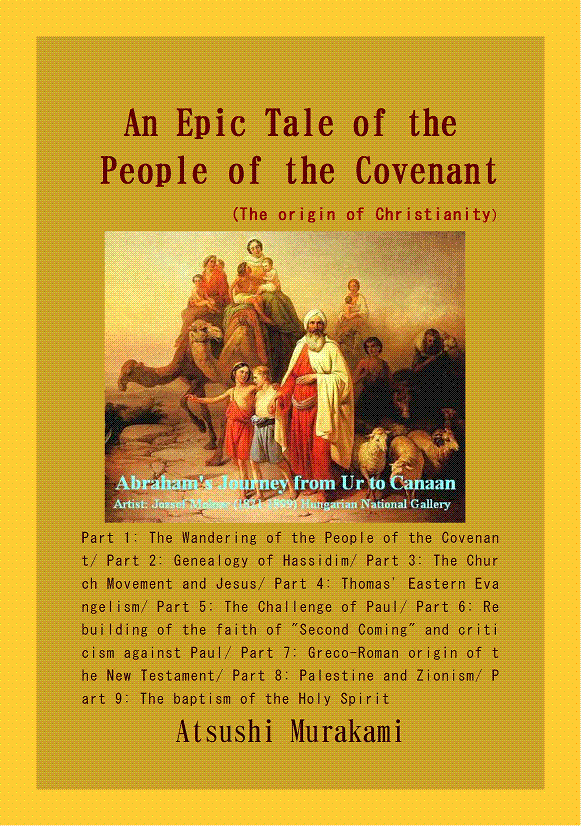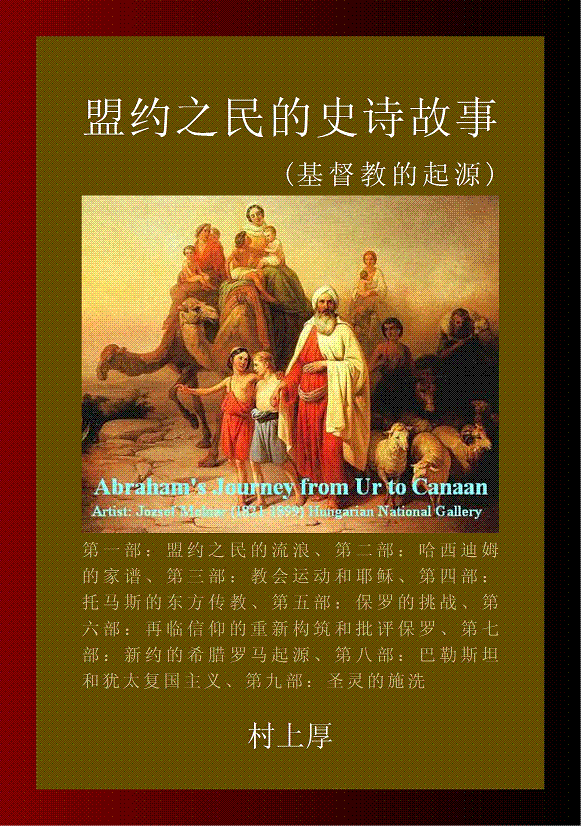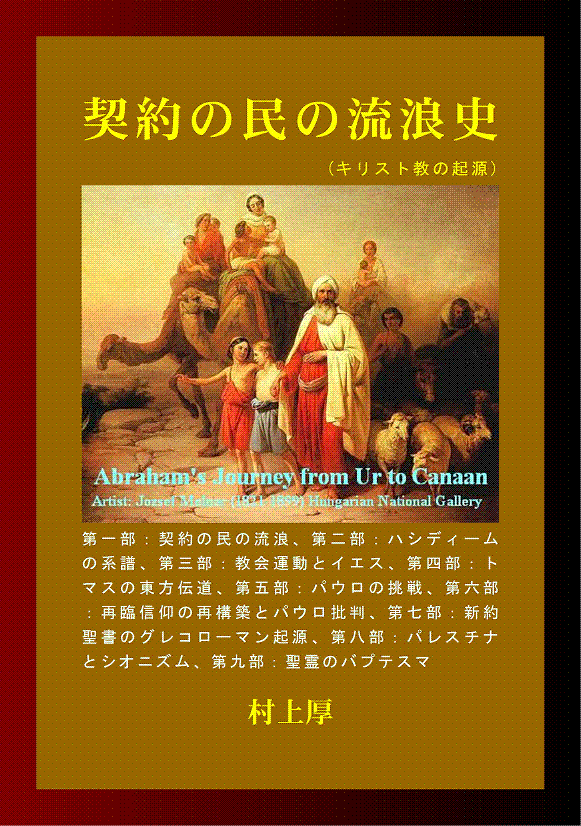| 右ペイン |
Review:The baptism of the Holy Spirit (Aramaic roots VII) Jesus said, "Perhaps people think that I have come to impose peace upon the world. They donot know that I have come to impose conflicts upon the earth: fire, sword, war. For there will be five in a house: There will be three against two and two against three, father against son and son against father and they will stand alone." (Thomas 16) According to Mr. Sasagu Arai, author of the Japanese version of The Gospel of Thomas, the verse sixteen of the Gospel of Thomas is almost in line with parallel articles in the Gospel of Matthew (10: 34-36) and the Gospel of Luke (12: 51-53), except for the last phrase. But the verse sixteen of the Gospel of Thomas does not describe the split between women (daughter and mother, wife and mother-in-law). Because the whole theme of the Gospel of Thomas is the independence of child (son = male) from father on earth (Thomas 23/49), and a woman must become a man to enter heaven. And the last sentence of the verse is certainly an addition by Thomas. Q source describes the split that takes place in a family by believing in Jesus and following Him, while, in the Gospel of Thomas, beyond that, the split, as the process in which "a child" becomes "One" especially from "father" together with Jesus, is emphasized. As confirming in the verse 4, becoming 'One' or 'Single one,' for Thomas, means 'recovering the original integration in himself.' 'Three-One mysterious substance' and the statue of Maitreya By the way, in the sphere of influence of the Eastern Church, there are many portraits of Jesus in a pose in which a ring is made with the ring finger and the thumb of his right hand, and the remaining three fingers are raised. This kind of portrait cannot be found in the sphere of influence of the Western Christian Church. These portraits are probably icons that symbolizes the doctrine of the Eastern Church's 'Three-One mysterious substance (三一妙身).' The words, "For there will be five in a house: There will be three against two and two against three, father against son and son against father," in the verse sixteen of 'The Gospel of Thomas' may also have something to do with these icons. Regarding 'Three-One mysterious substance,' at the beginning of its inscription, Daqin Jingjiao Popular Chinese Monument (大秦景教流行中国碑: Nestorian Stele) says, "Lo the unchangeably true and invisible, who existed through all eternity without origin; the far-seeing perfect intelligence, whose mysterious existence is everlasting; operating on primordial substance he created the universe, being more excellent than all holy intelligences, inasmuch as he is the source of all that is honorable. This is our eternal true lord Allah (阿羅訶歟), Three-One mysterious substance. He appointed the cross as the means for determining the four cardinal points, he moved the original spirit, and produced the two principles of nature;" and describes 'Three-One mysterious substance (三一妙身)' as the substance of Allah (Yahweh). In other words, the guardian deity of Jingjiaotu (景教徒: Believers of Luminous Religion) was Allah, and the Muslims are also considered to have followed it. Then what is 'three'? In light of the 'Trinity' doctrine in the Western Church, the general interpretation is to say "God" as Father, "Jesus" as the Son, and "the Holy Spirit." While, Laozi (老子), a Chinese thinker in Spring and Autumn period (BC770-BC500), wrote in his book, 'Tao Te Ching (道徳経)' that "everything consists of 'yin (陰)' and 'yang (陽),' but 'the way of humanity' is neither 'yin' nor 'yang.' It is 'qi ([?]),' and 'qi' is the chaos, which is not yet divided into 'yin' and 'yang' like the primordial universe." It is reminiscent of 'recovering the original integration in oneself' taught by 'Gospel of Thomas' and the doctrine of 'Three-One mysterious substance' described on the Nestoriam Stele. By the way, the pronunciations of "[?]" and "気" in Chinese are the same, and they have almost the same meanings, but the former is used as a philosophical term. In English, they correspond to 'Holy Spirit' and 'spirit.' Regarding 'One', 'Daodejing' says, "All things are produced because they have "One" and kings have sovereignty because they have "One". "One" gives them their essence.(Ch 39)" And it also says, "'The way' produces One. One produces Two. Two produces Three. Three produces all things. All things are carrying 'yin (陰)' and holding 'yang (陽).' These two are harmonized by the mediating breath (沖気). (Ch 42)" Wang Bi(王弼 226-249), a great thinker of the Xuanxue (玄学: Dark Learning, Mysterious Learning or Profound Learning) during the Wei, Jin, and Southern and Northern Dynasties (魏晋南北朝) era, said, "'One (一)' is the beginning of the number, and this is the extreme of things, so called 'Miaoyou (妙有mysterious-being),' he who wants to be called 'You (有being),' doesn't see its shape, so it is not being, therefore, it's called 'miao (妙mysterious).' Though someone wants to call it 'Wu (無nothing),' but things are born because of this, so it is not 'Wu,' that is why it is 'You (有).' This is 'You (有)' existed in 'Wu (無),' thus it is called 'Miaoyou (妙有mysterious existence).' As it means that 'Miaoyou (妙有) is 'One (一)' that is the beginning of the number and is the extreme of things, and it is neither 'You (有)' nor 'Wu (無)' but exists both in 'You (有)' and 'Wu (無).' By the way, Xuanxue (玄学) is a scholarship that interpreted Yijing (易経), Laozi (荘子) and Zuangzi (荘子), which were called the 'sanxuan (三玄three mysteries),' and was popular during the Wei, Jin, and Southern and Northern Dynasties era of China. Sengzhao (僧肇), who was known as one of the four Sages among Kumaarajiiva (鳩摩羅什350-409)'s three thousand students and the best 'emptiness' theoretician, said in his book 'Zhaolun Niepanwuminglun (肇論:涅槃無名論),' Chapter 4, "The true way is in the complete enlightenment, and the complete enlightenment is in the bare truth. If you have got the bare truth, you would see both presence and absence. If you see both presence and absence, there is no difference between the other and you. Therefore heaven, earth, and I have the same root and myriad things and I are one body." The doctrine of 'Three-One mysterious substance' reflects the experiences that Thomas gained in his trip of preaching India and China, and the influences of Buddhism and Taoism are strongly felt. Moreover, this kind of influence is bidirectional, and it is considered that the Mahayana Buddhist schools that were prosperous in India at that time and the philosophies of Tiantai (天台) and Hua-yan (華厳) that emerged in China after that were also greatly stimulated by the Gnostic Christianity taught by Thomas. It can be said that the Buddha's three-body theory (仏陀三身説), that is, 'Dharmakaya (法身) which symbolizes the absolute truth or Li (理: universality), Nirmanakaya (応身) which symbolizes actual Buddha appeared in this historical world under spatial and temporal limitations or Shi (事: particularity) and Sambhogakaya (報身) which symbolizes interfusion between Li (理: universality) and Shi (事: particularity)' is a typical example. It may be mentioned that just around that time Fazang (法蔵643–712). who became a priest in obedience to the Imperial order and succeeded to the third patriarch of the Huayan school of Buddhism (華厳宗) and lectured to Empress Wu ZeTian (則天武后) and other high ranked officials on Huayan philosophy (華厳哲学) in the court, was from Sogdiana, one of Aramaic countries in western region of China. The statue of Maitreya Bodhisattva (弥勒菩薩像), which is said to have been given to Japan by Silla in 603 AD, in Koryuji Temple (広隆寺), makes that shape of fingers of its right hand. At that time, Koguryo, Silla, and Baekje stood on the Korean Peninsula, each striving to strengthen their relationship with Japan. Though the tribe in Kitakyushu, led by Emperor Jimmu (神武天皇)'s older brother Inainomikoto (稲飯命), seems to have had a blood relation with Kingdom of Silla (新羅), Yamato Kingdom (大和王権) had taken a diplomatic stance supporting Baekje (百済) since the Emperor Ojin (応神天皇)'s reign. When Baekje, which had invaded by Silla, asked Japan to rescue. Emperor Keitai (継体天皇) tried to send an expeditionary force to Korean Peninsula, but Iwai (磐井), a clan of Tsukushi in Kitakyushu, revolted joining hands with Silla. Even in the days of Prince Shotoku (聖徳太子), Soga (蘇我) and other clans linked Baekje were preparing to dispatch troops to Korea. Therefore, Silla sent to Japan the statue of Maitreya Bodhisattva, which symbolizes the doctrine of 'Three-One mysterious substance,' perhaps in order to restore old relations with the Yamato Imperial Court returning to the Emperor Jimmu's era. At that time in Silla there were several groups of knights called Hwa-rang (花郎) composed of children of the noble families who worshiped Mireuk-posal(弥勒菩薩) and played an active role in the Kingdom. The Maitreya Faith of Silla seems to have incorporated the doctrine of 'Three-One mysterious substance' of the primitive Christianity which had been believed by Yamato Imperial family and Hata clan (秦氏). Click here to read more.One world:AD-SEAnews Your Comments / Unsubscribe SEAnews Messenger SEAnewsFacebook SEAnews eBookstore SEAnews world circulation |    The origin of Christianity:An Epic Tale of the People of the Covenant In the region from Mesopotamia situated within the Tigris–Euphrates river to Palestine, city states, where agricultural and nomadic people had lived together, have risen and fallen since ancient times. The agricultural people played leading role in the most of these city states. However, the nomads, such as Reuben, Simeon, Levi, Judah, Issachar, Zebulun, Joseph, Benjamin, Dan, Naphtali, Gad, Asher, Manasseh, Ephraim and so on formed a union of independent tribes and established the unity of religion and politics based on the covenant of the single founder Abraham and God from 3,000 to 4,000 years ago in Palestine region and appeared on history's center stage replacing agricultural people. Thus the People of the Covenant was born.
In [Part 1: The Wandering of the People of the Covenant] of this book, let's look at 'the birth of the People of the Covenant,' 'the formation of tribal nation,' 'the division and destruction of nations,' 'the period of Persian rule' and 'the period of Hellenistic rule.'
In [Part 2: Genealogy of Hassidim], let's examine the periods of 'Maccabean Revolt,' 'Hasmonean Dynasty,' and 'Herod Dynasty.'
In [Part 3: The Church Movement and Jesus] let's examine the relationship between 'the Church Movement' and Jesus, his disciples, the High Priest, and the royal family. In [Part 4: The Challenge of Paul] we will focuse on Paul's teachings and Paul's missionary work.
In [Part 5:Rebuilding of the faith of "Second Coming" and criticism against Paul], we will focus on rebuilding the faith of the second coming after the Jewish war and the criticism against Paul that arose in the rebuilding process.
In [Part 6: Palestine and Zionism] we will examine the current situation of Israel and Palestine in the context of the theme "The Wandering of the People of the Covenant."
In [Part 7: The baptism of the Holy Spirit], let's look at the spirit behind the words of Jesus and his disciples written in "Gospel of Thomas", "Acts (Paul)", "Gospel of John" and "Gospel of Matthew." Atsushi Murakami, May 2019 in Singapore  Peace, Jesus has left with us (John 14:27), is now obvious.
In both the east and west, despite differences of religion, the wisdom needed to survive turbulent times is the same. The secret of "Baptism of the Holy Spirit" taught by Jesus was brought in Mahayana Buddhism, Islam and other religions and has inherited until now. I would be pleased if I could share the essence of the baptism of the Holy Spirit with the readers of this book.  基督教的起源:盟约之民的史诗故事 从底格里斯-幼发拉底两条河流之间的美索不达米亚到巴勒斯坦的地区,自古以来农业民族和游牧民族共同生活的城邦兴亡。在大多数的这些城市里农业民族扮演主角。不过,大约在3000年到4000年前,游牧民族,如; 流便(Reuben),西缅(Simeon),利未(Levi),犹大(Judah),以萨迦(Issachar),西布伦(Zebulun),约瑟(Joseph),便雅悯(Benjamin),但(Dan),拿弗他利(Naphtali),迦得(Gad),亚设(Asher),玛拿西(Manasseh)和以法莲(Ephraim)等等,在巴勒斯坦地区组织了基于单一始祖亚伯拉罕与上帝盟约的一个独立的部落联盟,也就是政教合一的政体从而取代农业民族首次出现在历史舞台上作为主角。这就是『盟约之民(People of the Covenant)』的诞生。
在本书《第一部:盟约之民的流浪》中,让我们看看『圣约之民诞生』,『部落国家的形成』,『国家的分裂与灭亡』,『波斯统治时期』和『希腊化时期』。
在《第二部:哈西迪姆的家谱》中,让我们看看『马加比家族起义』,『哈斯莫纳王朝』和『希律王朝』时期。
在《第三部:教会运动和耶稣》中,让我们看看『教会运动』与耶稣,他的门徒,大祭司和王室之间的关系。
在《第五部:再临信仰的重新构筑和批评保罗》中,我们将关注在第二次犹太战争后的重建再临信仰以及在重建过程中出现的对保罗的批评。
在《第七部:圣灵的施洗》,让我们看看耶稣和他的门徒在『托马斯福音』,『使徒行传(保罗)』,『约翰福音』和『马太福音』里所说话背后的灵。 村上厚
敬呈于2019年5月在新加坡 和平,耶稣留给我们的(约翰14:27),现在已明朗。
无论东方或西方,宗教的差异,在动荡时代生存的要谛皆立基于此。耶稣教导的"以圣灵施洗"的奥秘被大乘佛教,回教和其他宗教继承,直到现在一脉相传。如果通过这本书能够与读者分享以圣灵施洗的精髓,喜出望外。  キリスト教の起源:契約の民の流浪史
チグリス川とユーフラテス川に挟まれたメソポタミアからパレスチナにかけた地域には、古くから農耕民と遊牧民が共生する都市国家が興亡して来た。大部分の都市国家の主役は農耕民だったが、ルベン族、シメオン族、レビ族、ユダ族、イッサカル族、ゼブルン族、ヨセフ族、ベニヤミン族、ダン族、ナフタリ族、ガド族、アシェル族 マナセ族、エフライム族等から成る遊牧民は、今から3000年乃至4000年前に単一の始祖アブラハムと神との契約に基づく祭政一致の部族聯合を組織、農耕民に替わって歴史の表舞台に登場した。契約の民の誕生である。
本書《第一部:契約の民の流浪》では、『契約の民の発祥』、『部族国家の形成』、『国家の分裂と滅亡』、『ペルシア属領時代』と『ヘレニズム時代』を俯瞰してみる。
《第二部:ハシディームの系譜》では、『マカバイ戦争』、『ハスモン王朝』、『ヘロデ王朝』の時代を考察する。
《第三部:教会運動とイエス》では、イエスおよびその弟子達や大祭司そして王室と『教会運動』の関わりを検証する。
《第四部:パウロの挑戦》では、『パウロの教え』と『パウロの布教活動』に焦点を当てる。
《第五部:再臨信仰の再構築とパウロ批判》では、ユダヤ戦争後の再臨信仰の再構築とその過程で生じたパウロ批判に注目してみる。
《第六部:パレスチナとシオニズム》は、『契約の民の流浪』と言うテーマとの関わりの中でイスラエルとパレスチナの現状を検証する。
《第七部:聖霊のバプテスマ》では、≪トマス福音書≫、≪使徒行伝(パウロ)≫、≪ヨハネ福音書≫、≪マタイ福音書≫に記されたイエスと弟子達の言葉の背後に隠されたスピリットに参じて見る。
村上厚
2019年5月 シンガポール  イエスが残した平安(ヨハネ14:27)が、今あきらかに。
洋の東西、宗教の如何を問わず、激動の時代を生き抜く要諦に変わりはない。イエスが説いた聖霊のバプテスマの奥義は、大乗仏教やイスラム教に受け継がれ、脈々と生き続けており、この書を通じて、読者とともに、聖霊のバプテスマの真髄を究尽できれば幸いである。 |
No comments:
Post a Comment